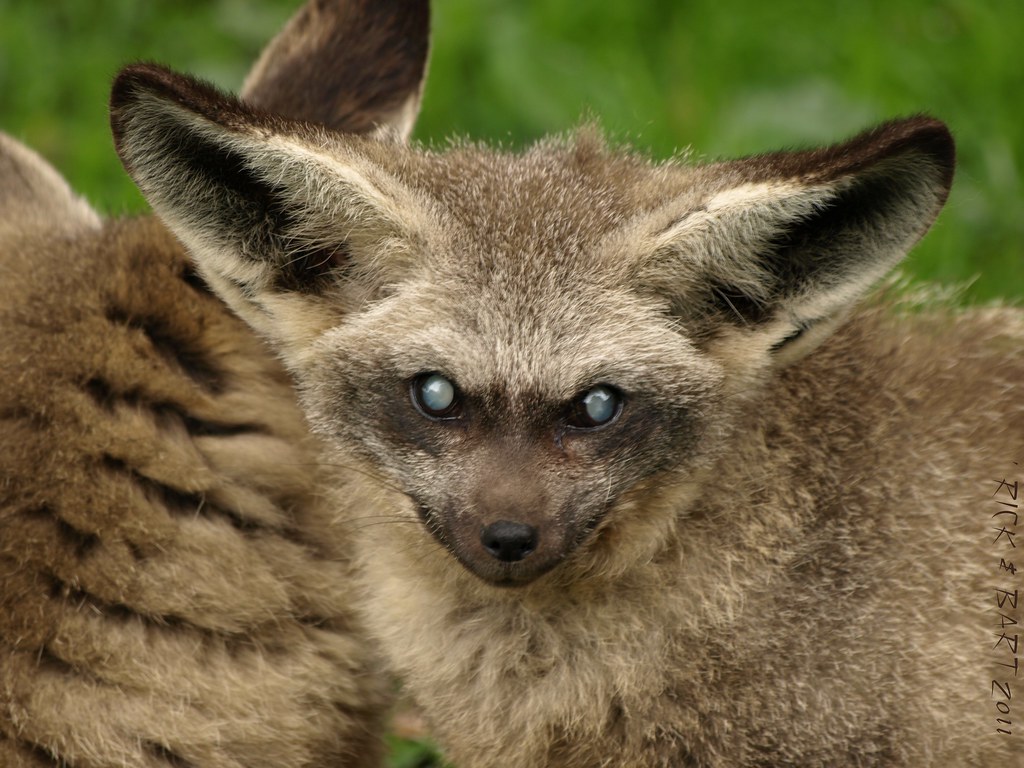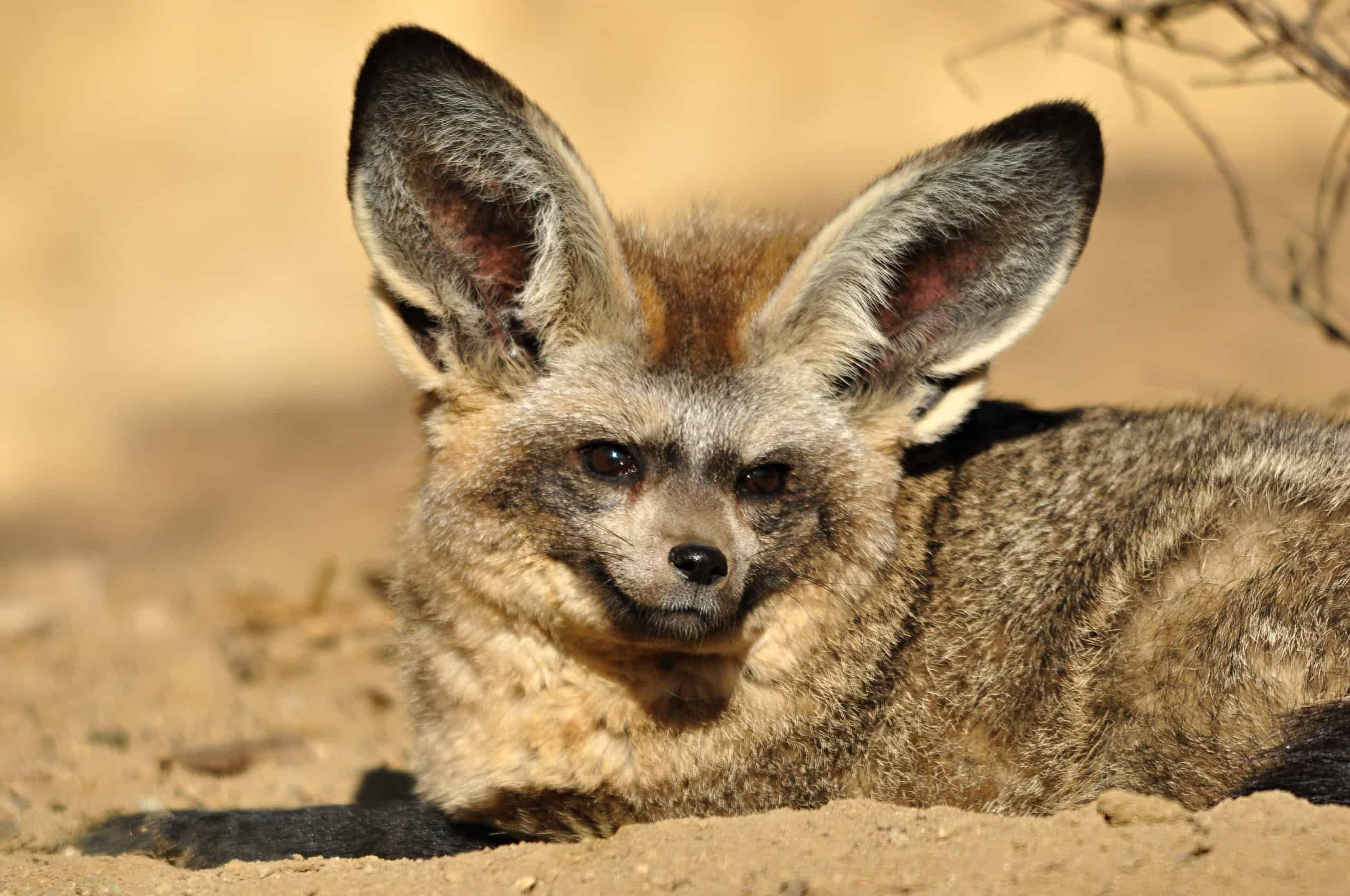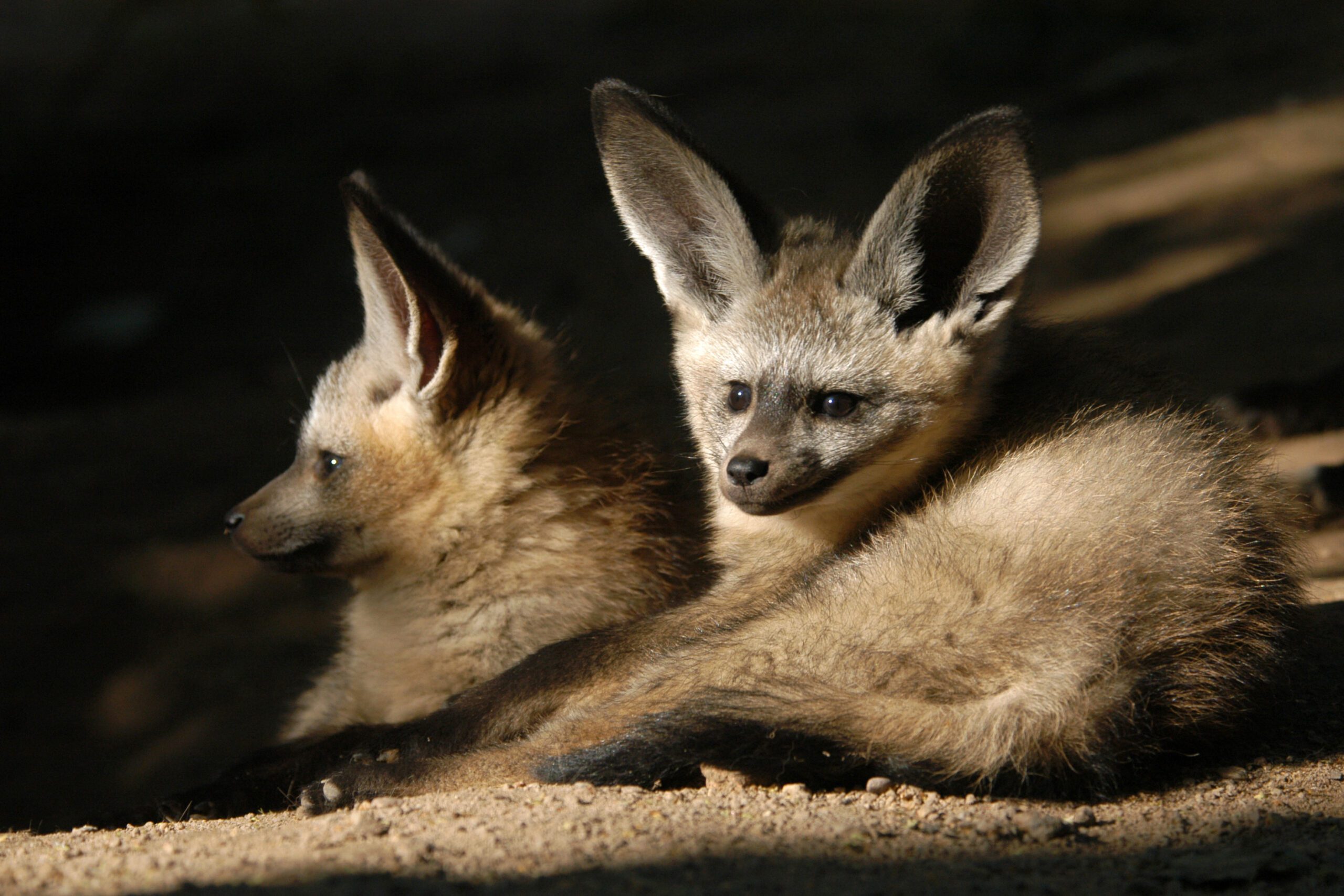Bat-Eared Fox (Otocyon megalotis), is a small and unique African canid species known for its distinctive oversized ears that stand over 5 inches (13 cm) tall and fascinating adaptations.
The ears are filled with blood veins that dissipate heat and keep the fox cool; they also provide the fox with a keen sense of hearing.
Sandy gray, with lighter fur on the abdomen and darker fur around the eyes, snout, back of the ears, paws, and tip of the long, bushy tail. The insides of the ears, as well as a band across the forehead, are white or buff.
Bat-eared foxes appear to like sharing their territory. In one square mile (2.6 square kilometers), up to 72 foxes have been observed.
Otocyon megalotis is the scientific name for the bat-eared fox. It is derived from the Greek words “oto/Otis” (ear), “cyon” (dog), and “mega” (large) and roughly translates to “eared dog with big ears.”
Bat-Eared Fox: Species Profile
COMMON NAME: Bat-Eared Fox
SWAHILI NAME: Mbweha Masikio
SCIENTIFIC NAME: Otocyon megalotis
TYPE: Mammal
FOOD: Bat-Eared Foxes primarily feed on insects, particularly termites. They have specialized teeth and jaws adapted for crushing and grinding the hard exoskeletons of termites. They also consume other small invertebrates, such as beetles and ants, and occasionally include small vertebrates like rodents in their diet.
HABITAT: Bat-Eared Foxes are found in open grasslands and savannas across eastern and southern Africa. They prefer areas with short grass where their prey, like termites, is abundant. They are also known to inhabit semi-arid regions and sandy deserts.
SIZE: Bat-Eared Foxes are small to medium-sized canids. They have a slender body with a length ranging from 55 to 75 centimeters (22 to 30 inches). They stand about 30 to 41 centimeters (12 to 16 inches) tall at the shoulder. Males and females are similar in size.
AVERAGE LIFE SPAN IN THE NATURAL HABITAT: The average lifespan of Bat-Eared Foxes in the wild is around 10 to 12 years. However, in captivity, they can live up to 15 years or more.
ACTIVE: Bat-Eared Foxes are primarily nocturnal creatures, meaning they are most active during the night. They have large, bat-like ears that help them locate insects in the dark. During the day, they rest in underground burrows to avoid the heat.
GESTATION PERIOD: The gestation period for Bat-Eared Foxes is approximately 60 to 70 days. Females give birth to litters of 2 to 6 pups in underground dens. Both parents take part in raising and caring for the young.
WEIGHT: Bat-Eared Foxes weigh between 3 to 5 kilograms (6.6 to 11 pounds). They have a unique appearance with their large ears, which aid in thermoregulation and detecting prey, and a light tan or grayish coat.
SIZE COMPARISON TO A 6-FT MAN: Bat-Eared Foxes are significantly smaller than a 6-ft man. With a body length of 55 to 75 centimeters (22 to 30 inches) and a shoulder height of 30 to 41 centimeters (12 to 16 inches), they are compact and lightweight animals. Their distinctive features and specialized diet make them a fascinating species in the African savannas.
Physical Characteristics:
The bat-eared fox (Otocyon megalotis) is a unique and distinctive small mammal found in certain regions of Africa. Here is a description of its appearance:
1. Size: The bat-eared fox is relatively small, measuring about 55 to 65 centimeters (22 to 26 inches) in length, excluding the tail. It stands at a height of around 30 to 41 centimeters (12 to 16 inches) at the shoulder. The tail adds an additional 25 to 30 centimeters (10 to 12 inches) to its overall length.
2. Body Shape: It has a slender and compact body shape, with a relatively short torso and limbs. The body is covered in soft, light brown or sandy-colored fur, which provides excellent camouflage in its arid habitat.
3. Ears: The bat-eared fox is most notable for its large, prominent ears, which are its defining feature. These ears are enormous in proportion to its head, measuring around 13 to 15 centimeters (5 to 6 inches) in length. The ears are held upright and are black in color, with white fur on the inner surface.
4. Facial Features: The bat-eared fox has a small, narrow face with a pointed snout. It has a distinct black nose and dark, oval-shaped eyes. The eyes are adapted for excellent nighttime vision, aiding in its nocturnal activities.
5. Teeth: The bat-eared fox has specialized teeth adapted for its unique diet. It has a large number of small, closely spaced teeth, including sharp incisors and molars. These teeth are specifically designed for chewing and grinding the hard exoskeletons of insects, which make up a significant portion of its diet.
6. Limbs and Paws: It has relatively long and slender limbs, equipped with non-retractable claws. The paws are adapted for efficient digging, as the bat-eared fox spends a significant amount of time excavating insect nests from the ground.
Overall, the bat-eared fox has a charming and distinctive appearance, with its large ears being the most prominent feature. Its small size, sandy-colored fur, and specialized adaptations make it well-suited for its unique ecological niche in the African savannas and arid regions.
A. Iconic Ears:
The most striking feature of the Bat-Eared Fox is its exceptionally large ears, which can measure up to 13 centimeters (5 inches) in length. These ears serve multiple functions, including thermoregulation, enhanced hearing capabilities, and detection of insect prey. They are also used for communication within social groups.
B. Unique Body Features:
The Bat-Eared Fox has a slender body with a sandy or grayish-brown coat, providing effective camouflage in its grassland habitats. Its muzzle is elongated and narrow, well-suited for its specialized diet. The species typically stands at a height of around 40 centimeters (16 inches) at the shoulder and weighs between 3.5 to 5 kilograms (7.7 to 11 pounds).
Habitat and Distribution:
A. Savanna Dwellers:
Bat-Eared Foxes are predominantly found in the grassland and savanna regions of Africa. They inhabit areas with a mix of open plains and shrub vegetation, which provide them with a suitable habitat for foraging and denning. They have adapted well to both arid and more humid environments.
B. Geographic Range:
The Bat-Eared Fox has a relatively wide distribution across eastern and southern Africa, including countries such as Botswana, Kenya, Namibia, South Africa, and Tanzania. Their ability to thrive in different savanna habitats showcases their adaptability to varying ecological conditions.
Social Behavior:
The bat-eared fox (Otocyon megalotis) exhibits interesting and unique behaviors. Here is a description of its behavior:
- Social Structure: Bat-eared foxes are highly social animals that live in small family groups. They typically form monogamous pairs that mate for life. These pairs are assisted by older offspring in raising the young.
- Nocturnal Activity: The bat-eared fox is primarily nocturnal, which means it is most active during the night. It has adaptations such as excellent night vision and large ears that help it navigate and locate prey in low-light conditions.
- Diet and Foraging: The bat-eared fox has a specialized diet that consists mainly of insects, particularly termites. They are highly efficient termite hunters and can consume thousands of termites in a single night. They also eat other invertebrates, small rodents, and occasionally plant material.
- Communication: Bat-eared foxes use a variety of vocalizations and body postures to communicate with each other. They produce a range of calls, including barks, chirps, and growls, which help in maintaining contact and expressing warnings.
- Burrow Dwelling: These foxes are known for their elaborate burrow systems, which they use for shelter and raising their young. The burrows provide protection from predators and extreme weather conditions.
- Grooming: Bat-eared foxes engage in mutual grooming, where they use their teeth and tongue to groom each other’s fur. This behavior helps strengthen social bonds within the family group.
- Territoriality: Bat-eared foxes defend their territories, marking them with scent markings and vocalizations to deter intruders. They have overlapping home ranges with neighboring groups but maintain exclusive core areas.
- Parental Care: Both parents actively participate in rearing their offspring. They provide food and protection to the young, who remain in the family group until they reach sexual maturity.
- Playful Behavior: Bat-eared foxes engage in playful activities, which help in developing their hunting and social skills. They chase each other, wrestle, and engage in mock fights as a form of social bonding and exercise.
- Seasonal Migration: In some regions, bat-eared foxes undertake seasonal migrations in search of food and suitable habitats. They move in groups and cover long distances during these migrations.
These behavioral traits make the bat-eared fox an intriguing and adaptable species, well-suited to its unique ecological niche in the African savannas and grasslands.
A. Family Units:
Bat-Eared Foxes typically live in small family groups consisting of a monogamous breeding pair and their offspring. These cohesive family units work together to raise young, defend territory, and forage for food. Their social structure promotes cooperation and enhances survival chances.
B. Vocal and Visual Communication:
Communication within Bat-Eared Fox groups involves a combination of vocalizations, body postures, and facial expressions. They produce a range of calls, including soft barks, yelps, and chirps, to convey messages related to warnings, mating, and group cohesion. They also use visual cues, such as tail movements and ear positions, to signal intent and maintain social bonds.
Feeding Habits:
A. Insectivorous Diet:
The Bat-Eared Fox is primarily insectivorous, with termites making up a significant portion of its diet. They have specialized teeth and a strong jaw that allow them to efficiently crush and consume termites. In addition to termites, they also consume other insects, small rodents, birds, and eggs, showcasing their opportunistic feeding behavior.
B. Adaptations for Termite Hunting:
The Bat-Eared Fox has unique adaptations that aid in termite hunting. Their large ears not only assist in detecting insect sounds but also aid in dissipating heat during foraging activities. Their teeth are adapted for grinding and chewing hard exoskeletons, enabling them to efficiently extract nutrition from termites.
Conservation Status:
The Bat-Eared Fox is currently listed as a species of “Least Concern” on the IUCN Red List. However, ongoing threats such as habitat loss, agricultural expansion, and human-wildlife conflict pose potential risks to their populations. Continued research, monitoring, and conservation efforts are crucial for ensuring the long-term survival of this remarkable species.
Otocyon megalotis
The Otocyon megalotis (Bat-Eared Fox), with its iconic ears, remarkable adaptations, and fascinating social behavior, is a true marvel of the African savannas. By raising awareness about this captivating species and supporting conservation initiatives, we can contribute to its protection and the preservation of the diverse ecosystems it inhabits.
Bat-Eared Fox Adaptations
The bat-eared fox (Otocyon megalotis) possesses several remarkable adaptations that contribute to its survival and success in its environment. Here are some notable adaptations of the bat-eared fox:
- Large Ears: The most distinctive adaptation of the bat-eared fox is its unusually large ears. These ears are about five to six inches long and serve multiple purposes. They provide exceptional hearing sensitivity, allowing the fox to detect the faint sounds of prey and potential predators. Additionally, the large surface area of the ears helps dissipate excess body heat in the hot African climate.
- Specialized Teeth: The bat-eared fox has unique dental adaptations that are well-suited for its insectivorous diet. Its teeth are small and closely spaced, with sharp incisors and molars. These teeth enable the fox to efficiently chew and grind the tough exoskeletons of insects, such as termites, which make up a significant portion of its diet.
- Nocturnal Vision: Being primarily nocturnal, the bat-eared fox has adapted to have excellent night vision. Its eyes are large and adapted to low-light conditions, allowing it to navigate and hunt effectively during the dark hours.
- Specialized Digestive System: The digestive system of the bat-eared fox is well-adapted to process its insect-rich diet. It has a relatively long and complex digestive tract, which aids in the efficient extraction of nutrients from the insects it consumes.
- Paw Structure: The bat-eared fox has specialized paws equipped with non-retractable claws. These claws are ideal for digging, as the fox spends a significant amount of time excavating insect nests from the ground. Its digging ability allows it to access subterranean prey and also helps in creating burrows for shelter.
- Camouflage: The sandy-colored fur of the bat-eared fox provides excellent camouflage in its arid habitat. The coloration blends well with the surroundings, making it less visible to both predators and prey.
- Efficient Thermoregulation: The large ears of the bat-eared fox not only aid in hearing and heat dissipation but also help regulate body temperature. By increasing blood flow to the ears, the fox can cool down through the process of vasodilation, allowing it to withstand high temperatures.
These adaptations have enabled the bat-eared fox to thrive in its specific ecological niche. Its specialized characteristics and behaviors make it highly adapted to its environment, allowing it to effectively locate and consume insects, avoid predators, and survive in the challenging conditions of the African savannas and grasslands.
Where to see bat-eared foxes in Tanzania
If you’re interested in observing bat-eared foxes (Otocyon megalotis) in Tanzania, there are a few locations where you might have a chance to encounter these fascinating creatures. While bat-eared foxes are generally found in various parts of East Africa, including Tanzania, please note that their sightings can be relatively rare and unpredictable. Here are some potential places where you might spot bat-eared foxes in Tanzania:
- Serengeti National Park: Known for its abundant wildlife, including a diverse range of predators and herbivores, Serengeti National Park offers a chance to spot bat-eared foxes. The grasslands and open savannas provide a suitable habitat for these foxes to thrive.
- Ngorongoro Conservation Area: As a vast and diverse conservation area, Ngorongoro provides opportunities for wildlife enthusiasts to encounter a variety of species, including bat-eared foxes. Keep in mind that sightings can be infrequent due to the foxes’ elusive nature.
- Tarangire National Park: With its unique landscape characterized by baobab trees, Tarangire National Park is home to an array of wildlife. Although bat-eared foxes are not commonly seen in this park, they may occasionally be spotted in the open grassy plains.
- Ruaha National Park: Located in central Tanzania, Ruaha National Park offers a different wildlife experience. While bat-eared foxes are not as commonly sighted here as some other species, the park’s diverse ecosystems provide a suitable habitat for these foxes.
When embarking on wildlife viewing expeditions, it’s important to remember that wild animals can be unpredictable, and sightings cannot be guaranteed. Patience, persistence, and the guidance of experienced guides and park rangers can significantly enhance your chances of spotting bat-eared foxes in their natural habitat.
Bat-eared fox Safari Tips
If you’re planning a safari to observe bat-eared foxes (Otocyon megalotis), here are some helpful tips to enhance your experience:
- Choose the Right Time: Bat-eared foxes are primarily nocturnal animals, so plan your safari during the early morning or late afternoon when they are most active. They tend to rest in burrows during the hottest parts of the day.
- Go with an Experienced Guide: Engage the services of a knowledgeable guide who is familiar with the behavior and habitat of bat-eared foxes. Their expertise can greatly increase your chances of locating these elusive creatures and provide valuable insights during the safari.
- Focus on Open Grasslands: Bat-eared foxes prefer open grasslands and savannas, where they can forage for insects. Concentrate your safari in areas known for their grassy plains, as these are more likely to attract bat-eared foxes.
- Use Binoculars and Spotting Scopes: Bat-eared foxes can be quite small and easily blend into their surroundings. Carry binoculars or a spotting scope to scan the landscape and spot any distant foxes.
- Stay Quiet and Observant: When you come across bat-eared foxes, maintain a respectful distance and minimize noise. These creatures are sensitive to disturbances, and excessive noise or movement may cause them to retreat.
- Be Patient: Wildlife viewing requires patience, as animals may not always be immediately visible. Take your time and allow the foxes to become accustomed to your presence. With patience, you may witness their fascinating behaviors.
- Respect Nature and Wildlife: Remember to follow ethical wildlife viewing practices. Avoid approaching or disturbing the foxes, and adhere to park regulations and guidelines. Respect their natural behavior and keep a safe distance to ensure their well-being and minimize any potential stress.
- Capture Memories Responsibly: If you plan to take photographs or videos of the bat-eared foxes, do so without causing disturbance. Use a telephoto lens to maintain distance and avoid using flash, which can startle the animals.
- Enjoy the Whole Safari Experience: While your focus may be on bat-eared foxes, embrace the overall safari experience and appreciate the diversity of wildlife and landscapes you encounter along the way. Every safari has unique encounters and surprises in store.
Remember, wildlife sightings cannot be guaranteed, as animals follow their natural patterns and may be influenced by various factors. Enjoy the adventure and the wonders of the African wilderness, and cherish any opportunity to observe the elusive bat-eared foxes in their natural habitat.
Frequently Asked Questions about Bat-Eared Foxes
- Are bat-eared foxes a type of bat?
No, bat-eared foxes are not bats. They are small mammals belonging to the canid family, which includes dogs and wolves. They are named for their large ears, which resemble those of certain bat species. - What do bat-eared foxes eat?
Bat-eared foxes have a specialized diet primarily consisting of insects, particularly termites. They have adapted to feeding on these tiny creatures by using their long, sharp teeth to extract them from termite mounds. - Do bat-eared foxes live in social groups?
Yes, bat-eared foxes are highly social animals. They typically live in small family groups, including a breeding pair and their offspring. These groups work together to forage for food, raise their young, and defend their territory. - Where are bat-eared foxes found?
Bat-eared foxes are native to the savannas and grasslands of Africa. They can be found in various countries, including Botswana, Namibia, South Africa, and parts of East Africa, including Tanzania. - How do bat-eared foxes communicate?
Bat-eared foxes use a range of vocalizations, including various barks and yelps, to communicate with each other. They also rely on body language, such as tail wagging and ear movements, to convey information. - What are the predators of bat-eared foxes?
Bat-eared foxes face predation from larger carnivores such as lions, hyenas, and leopards. However, their excellent hearing and tight-knit social structure help them detect and respond to potential threats. - Do bat-eared foxes hibernate?
No, bat-eared foxes do not hibernate. They are active throughout the year and do not undergo a period of prolonged inactivity like some other mammals. - Are bat-eared foxes endangered?
While bat-eared foxes are not currently classified as endangered, they face threats such as habitat loss, predation, and disease. Conservation efforts aim to monitor their populations and protect their natural habitats. - How long do bat-eared foxes live?
Bat-eared foxes have an average lifespan of around 10 to 12 years in the wild. In captivity, they may live slightly longer. - Can bat-eared foxes be kept as pets?
No, bat-eared foxes are wild animals and are not suitable to be kept as pets. They have specialized needs and require specific environments and diets that cannot be easily replicated in a domestic setting.
Remember, if you encounter bat-eared foxes in the wild, it’s important to observe them from a distance and respect their natural behavior. Enjoy the opportunity to learn about these unique and fascinating creatures while ensuring their well-being and conservation.









Tour Reviews
There are no reviews yet.
Leave a Review